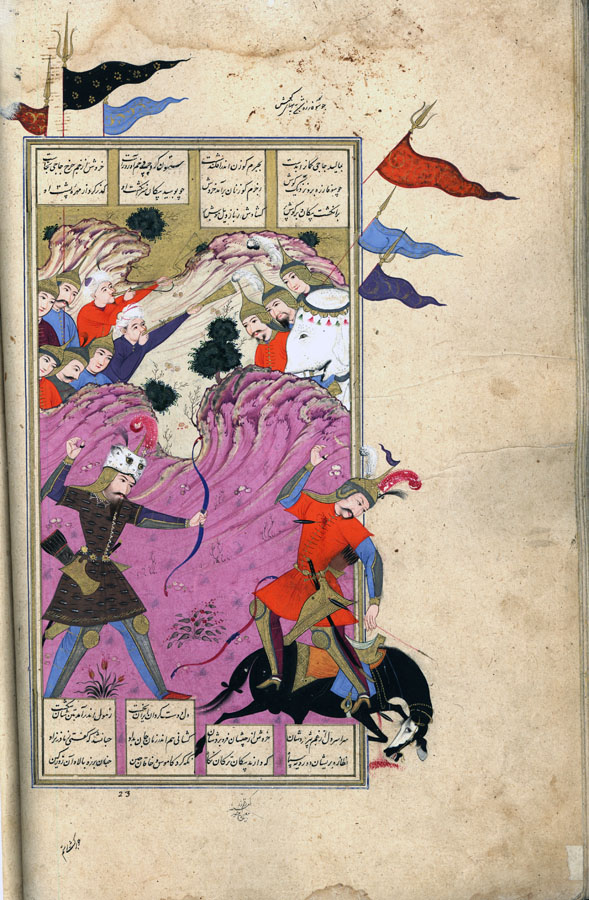Rostam Slays Aškabus and His Horse
The incident is portrayed just as Rostam’s arrow has found its mark in Aškabus. The composition is straight forward and lacks the originality of organization that other illustrations in the manuscript possess. The Turānian’s mount, a black horse with a white face, lies in the lower right foreground, an arrow deeply imbedded in its chest, its head and forequarters protruding beyond the frame. Aškabus, in a quasi-standing position, reels backward with an arrow protruding from his chest; he is ambiguously placed in space, neither on the ground nor on his horse, seemingly floating in the air. Clad in full battle gear with pointed steel helmet, quiver, bow case, and sword on his belt, his right arm is raised aimlessly, while in his left he still clutches an arrow. The bow has fallen to the ground alongside him. Opposite him, in the left foreground, is his adversary Rostam, recognizable in his tiger skin coat and leopard skin headdress. Unlike Aškabus, Rostam has both feet firmly planted on the ground. His left arm is extended straight with bow in hand, and his right arm is bent behind his ear having just let loose the arrow that felled Aškabus. The barren mauve colored landscape rises until it forms a craggy rock crest that resembles breakers on a beach. There is a depression in the middle with a few small bushes. In the far distance is a second ridge that echoes the first in form, and between the two ridge lines two groups of faces appear to observe the event. On the right, only their heads being visible, are three Turānian soldiers and the head of a white elephant. On the left side are five Iranian soldiers, similarly attired, and two turbanned horn blowers that herald the event.
There are four columns of text above and below the painting. At the top, two columns have three lines each, and the remaining columns two lines each. At the bottom, the columns contain the same number of lines, but juxtaposed with the top columns, so that overall top and bottom each column contains five lines of text. A rectangular frame encloses painting and text. In the lower right, the left arm, foot, and head of Aškabus, and the forequarters of his horse protrude into the right margin. Six standards, three at the top and three on the right, also protrude into their respective margins. The painting is signed in the lower margin, just to the right of center, in miniscule characters in Moʿin’s hand: raqam zad kamina moʿin-e moṣavver. The inscription is not dated.
Painting references:
Welch, AK4_1978, p.90, Ms.22, folio 157v (not ill.).
Text references:
Warner, III, pp.179-81; Mohl, III, pp.97-98; Levy, p.136.
Robert Eng
Last Updated: July 6, 2011 | Originally published: July 6, 2011
